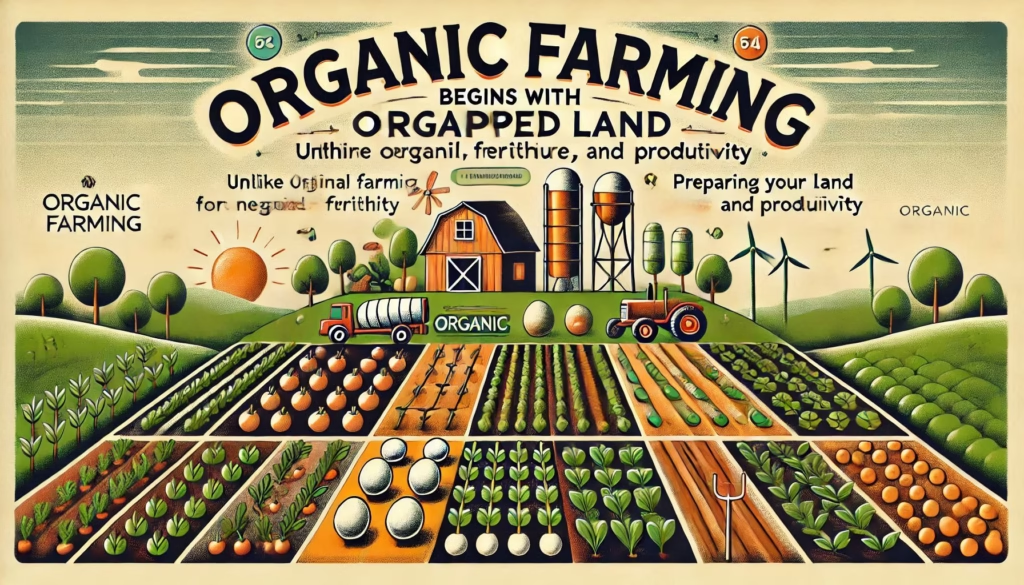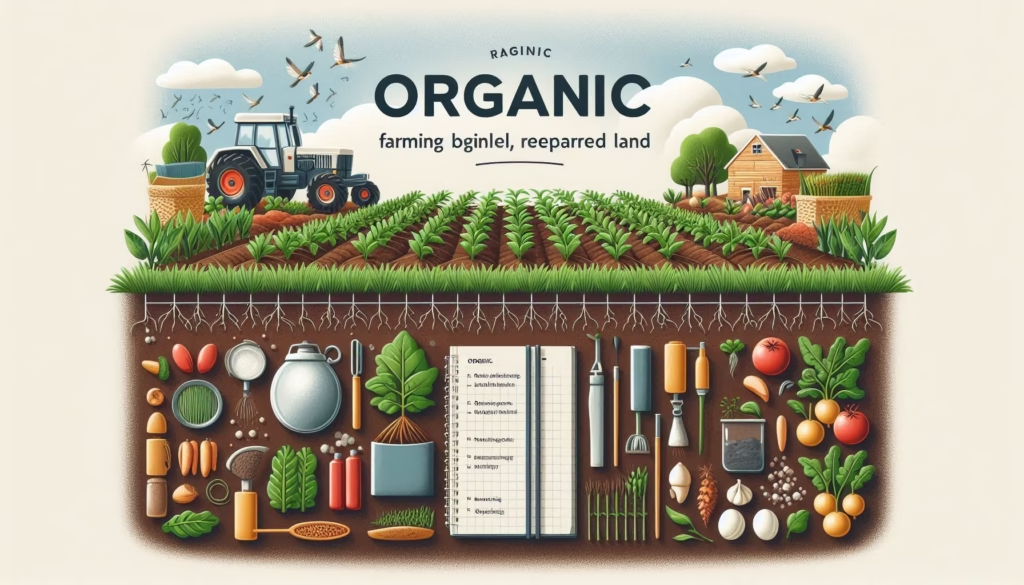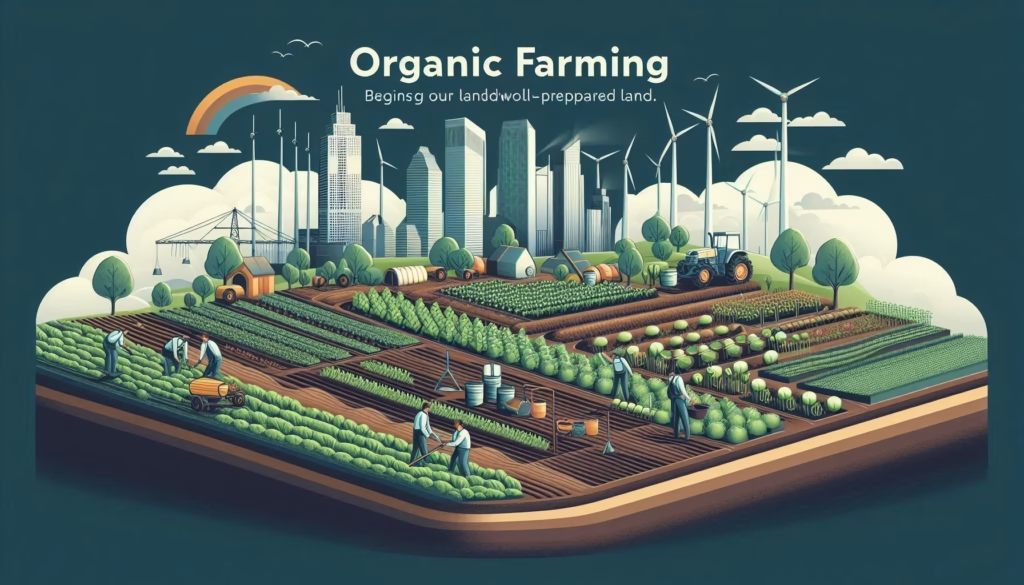Organic farming begins with well-prepared land. Unlike conventional farming, organic farming avoids synthetic chemicals and relies on natural techniques to ensure soil fertility, structure, and productivity. Preparing your land thoughtfully sets the stage for healthy crops and sustainable yields. Here’s a comprehensive guide to preparing your land for organic farming without using chemicals.

Why Proper Land Preparation Matters urban farming
Land preparation is crucial for:
- Improved Soil Health: Ensuring optimal conditions for plant roots and beneficial microorganisms.
- Weed Control: Reducing weed growth through natural means.
- Efficient Water Use: Enhancing water retention and drainage.
- Crop Success: Creating an environment where crops can thrive without synthetic inputs.
Steps to Prepare Your Land for Organic urban farming
1. Evaluate Your Soil
Before starting, understand your soil’s characteristics:
- Test Soil Quality: Conduct a soil test to determine pH, nutrient levels, and organic matter content.
- Identify Deficiencies: Look for nutrient imbalances or other issues that may need addressing.
- Assess Drainage: Check how well the soil drains and retains moisture.
2. Clear the Land
Remove any debris, rocks, or unwanted vegetation from your field:
- Manual Clearing: Use tools like hoes and shovels for small-scale plots.
- Mechanical Methods: For larger areas, use tractors with attachments such as plows or tillers.
- Avoid Burning: Instead of burning vegetation, compost it to create organic fertilizer.
3. Improve Soil Fertility Naturally
Organic farming relies on enriching the soil with natural amendments:
- Compost: Add compost made from kitchen scraps, yard waste, or farm residues to boost organic matter.
- Manure: Use well-rotted animal manure to provide essential nutrients.
- Green Manure: Plant cover crops like clover, alfalfa, or rye to fix nitrogen and improve soil structure.
4. Adjust Soil pH
Soil pH influences nutrient availability:
- Acidic Soils: Add lime to raise the pH to a neutral level.
- Alkaline Soils: Use sulfur or organic matter to lower the pH.
- Monitor Changes: Regularly test soil pH to ensure it remains suitable for your crops.
5. Implement Weed Management

Weeds compete with crops for nutrients, water, and sunlight. Control them naturally:
- Mulching: Cover the soil with organic mulch, such as straw or wood chips, to suppress weeds.
- Cover Crops: Use cover crops to shade out weeds and improve soil health.
- Manual Removal: Hand-pull weeds or use mechanical weeders regularly.
6. Choose Appropriate Tillage Methods
Tillage prepares the soil for planting and improves aeration:
- Shallow Tillage: Lightly till the soil to preserve its structure and microbial life.
- No-Till Farming: Leave the soil undisturbed to promote organic matter retention and reduce erosion.
- Use Natural Implements: Use animal-drawn plows or manual tools for small-scale operations.
7. Enhance Soil Structure
Good soil structure promotes root growth and water infiltration:
- Add Organic Matter: Incorporate compost and green manure to build a crumbly, aerated soil texture.
- Avoid Over-Tilling: Excessive tilling can compact the soil and destroy its structure.
- Introduce Earthworms: Encourage earthworms, which naturally aerate and enrich the soil.
Irrigation Planning in urban farming

Effective water management is essential for organic farming:
- Assess Water Sources: Identify reliable water sources, such as rainwater harvesting, ponds, or wells.
- Install Efficient Systems: Use drip irrigation or sprinklers to deliver water directly to plant roots.
- Mulch for Retention: Apply mulch to conserve soil moisture and reduce evaporation.
Promote Soil Biodiversity
Healthy soil is teeming with life, including bacteria, fungi, and insects:
- Use Organic Amendments: Feed soil microbes with compost, green manure, and organic fertilizers.
- Avoid Synthetic Chemicals: Pesticides and herbicides harm beneficial organisms.
- Rotate Crops: Practice crop rotation to break pest and disease cycles and maintain soil health.
Plan Your Crop Layout urban farming
Crop planning ensures efficient use of land and resources:
- Companion Planting: Grow complementary crops together to enhance growth and deter pests.
- Crop Rotation: Alternate crops annually to prevent nutrient depletion and control pests.
- Zoning: Allocate specific zones for different crops based on their needs.
Benefits of Chemical-Free Land Preparation
1. Environmental Protection
Avoiding chemicals prevents soil and water contamination, promoting a healthier ecosystem.
2. Cost Savings
Using natural amendments and techniques reduces reliance on expensive chemical inputs.
3. Long-Term Soil Health
Organic practices build soil fertility and structure, ensuring sustainability for future generations.
4. Resilience
Land prepared organically is more resilient to drought, pests, and diseases, reducing risks for farmers.
Common Challenges and Solutions
1. Initial Weed Pressure
- Solution: Use mulches and cover crops to suppress weeds effectively.
2. Low Nutrient Levels
- Solution: Gradually build fertility through compost, manure, and crop residues.
3. Pest and Disease Management
- Solution: Rotate crops, introduce natural predators, and use organic pesticides when necessary.
Conclusion
Preparing your land for organic farming is a rewarding process that requires patience and dedication. By focusing on natural techniques and prioritizing soil health, you can create a thriving, sustainable farming system that benefits both the environment and your crops. As you embark on this journey, remember that every effort you make contributes to healthier soil, cleaner water, and a more sustainable future.
Are you ready to prepare your land for organic farming? Share your thoughts, experiences, or questions in the comments below!
5 Questions and Answers on Preparing Land for Organic Farming urban farming
1. Why is land preparation important in organic farming?
Proper land preparation ensures optimal soil health, weed control, water efficiency, and better crop success. Organic methods promote sustainable practices that enrich the soil, reduce dependency on chemicals, and create a thriving environment for crops.
2. How can farmers naturally improve soil fertility?
Farmers can use organic compost, well-rotted manure, and green manure (cover crops like clover or rye). These natural amendments boost nutrient levels, enhance soil structure, and promote microbial activity without relying on synthetic fertilizers.
3. What are some effective natural weed management techniques?
Natural weed control methods include applying organic mulch (e.g., straw or wood chips), planting cover crops to shade out weeds, and manually removing weeds with hand tools or mechanical weeders. These methods prevent competition with crops for nutrients, water, and sunlight.
4. How can farmers enhance soil biodiversity?
Encouraging soil biodiversity involves using organic amendments like compost, avoiding synthetic chemicals, practicing crop rotation, and fostering conditions that support beneficial organisms like earthworms and microbes.
5. What are the benefits of chemical-free land preparation?
Chemical-free preparation protects the environment, reduces costs, improves long-term soil health, and creates resilience against drought, pests, and diseases. These practices ensure a sustainable and productive farming system for future generations.


